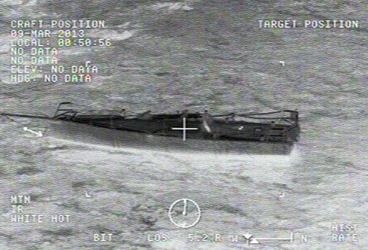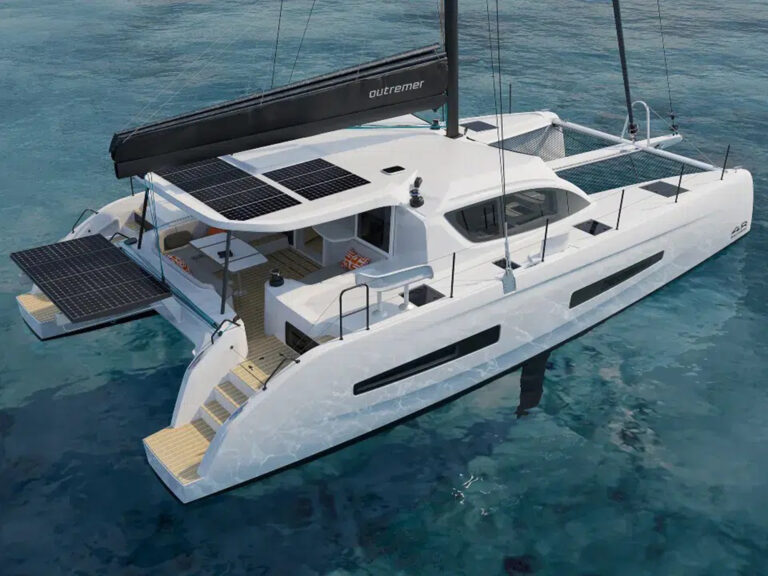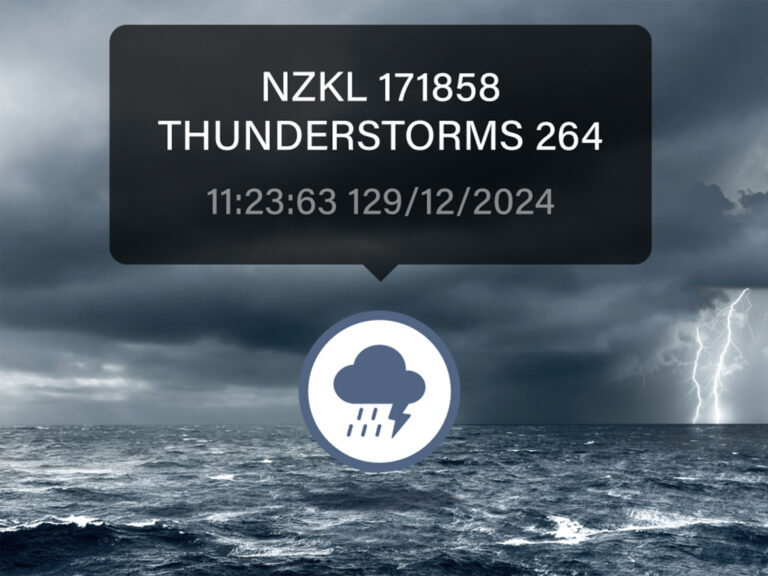
Uncontrollable Urge
US Sailing has released a report of an independent review panel on its investigation of the sailing accident that occurred off the coast of Southern California on Friday, March 8 during the 2013 Islands Race. The accident resulted in the death of a sailor.
The 2013 Islands Race Organizing Authorities of the San Diego Yacht Club and Newport Harbor Yacht Club jointly requested that US Sailing, the National Governing Body of the Sport, conduct an independent review of the accident to study the event and circumstances encountered by the crew of Uncontrollable Urge during the race. The panel was responsible for researching the factors pertaining to the accident by reviewing safety policies, procedures and equipment.
The panel has identified a set of recommendations for consideration to help prevent similar future tragedies. The panel shared their report with the Organizing Authorities, crew of Uncontrollable Urge, and family members of the deceased sailor.
Crew members aboard Uncontrollable Urge, a Columbia Carbon 32 sailboat, encountered dangerous conditions when their vessel’s rudder failed while sailing along the shore of San Clemente Island. Rough seas drove the 32-foot sailboat into the surf line causing major damage and the crew of six was forced to abandon the vessel. The Coast Guard was able to rescue five of the six sailors aboard.
The fourth annual Islands Race began Friday, March 8 inside the Los Angeles breakwater near Long Beach and the race finished in San Diego on Saturday, March 9. The route is 139 nautical miles and rounds the San Clemente and Catalina Islands. Uncontrollable Urge was one of 40 boats competing in the race.
Here is a summary of the panel’s findings and recommendations detailed in the report:
Panel Findings:
1. The accident was caused by the failure of the vessel’s rudder while sailing off a lee shore.
2. The emergency rudder preparations on Uncontrollable Urge were not adequate for the conditions in which the original rudder failed, despite the efforts of the crew.
3. The panel believes that if the skipper of Uncontrollable Urge told the USCG they were in distress initially when the rudder broke the USCG would have responded by sending help immediately. Even if assistance from the USCG was not needed it would have increased their options for rescue.
4. Help from the race boats would have given Uncontrollable Urge additional options for rescue.
5. The flight time for the USCG the night of the Islands Race was 50 minutes for the helicopter to be on the scene and another 60 minutes to ready hoist operations and pull the crew to safety. Before the USCG arrived the crew of Uncontrollable Urge had to be self-sufficient.
6. By the time the skipper of Uncontrollable Urge asked for assistance from other racers the vessel was one mile from the shore. Other race boats that could have responded with assistance were a considerable distance downwind and it is unlikely that those vessels would have been able assist Uncontrollable Urge due to her proximity to the lee shore.
7. The course of Uncontrollable Urge after the rudder failure was almost entirely dictated by the wind and swell direction. Her position was always moving towards the Island.
8. None of the emergency steering methods tried by the crew of Uncontrollable Urge worked in the conditions. The requirement of OSR 4.15.1 b) is “crews must be aware of alternative methods of steering the yacht in any sea condition in the event of rudder loss. At least one method must have been proven to work on board the yacht”. The crew of Uncontrollable Urge assumed that since they had success steering Columbia 32C hull #1 off of Newport Beach, Calif. in 10 knots of wind using just the sails they would be able to steer Uncontrollable Urge in the conditions they found off of San Clemente Island during the Islands Race.
9. The crew of Uncontrollable Urge found that even with the engine at full throttle none of the emergency steering measures gave them enough directional stability to counteract the leeway generated by the large sea state. If no methods of emergency steering have been tried prior to a rudder failure there is no way to know if the emergency steering method will work in any sea condition.
10. Four of five Spinlock deck vests failed to work properly, allowing the flotation chamber to pull over the wearer’s head to one side of the body. The deceased was found floating face down with the flotation chamber pulled over his head. Given that the crew had to swim through large surf to reach the shore this was a life threatening failure.
11. OSR Category 3 is defined as “Races across open water, most of which is relatively protected or close to shorelines.” US Sailing prescribes “that Category 2 races are of extended duration along or not far removed from shorelines, where a high degree of self-sufficiency is required of yachts but with the reasonable probability that outside assistance would be available for aid in the event of serious emergencies”. While the Islands Race has a rated distance of 129.5 nautical miles the northwest corner of San Clemente Island is 75 miles from San Diego Buoy #1 and therefore in inclement conditions help is not readily available.
Panel Recommendations:
1. Vessels that race offshore should have adequate rudders so that heavy weather sailing conditions do not cause them to break. This may require plan approval or an inspection from a naval architect or marine surveyor.
2. Crews should be aware of how to contact the Coast Guard or other vessels and to indicate the amount of assistance required. The US Sailing Safety at Sea Course should address how to communicate clearly with the USCG and other race vessels in case of distress. A broken rudder should be considered an emergency situation in heavy seas and high winds. Specifically, sailors should understand when a Mayday or PAN PAN urgency transmission is justified. Crews must be realistic about their level of danger.
3. US Sailing should recommend that all race boats post near the VHF clear directions on how to communicate when the vessel is in distress. Some VHF instruction manuals have specific language on how to communicate when the vessel is in distress that skippers and crews should read.
4. Skippers and crews need to be aware of methods of rendering assistance to other vessels, including providing skills and advice, providing tools, acting as a communications relay, towing, and transfer of crews.
5. When sailors are in a life threatening situation, they should seek and pursue all possible options for assistance, including accepting assistance from other vessels.
6. The US Sailing Safety at Sea Committee should recommend that the Offshore Special Regulations Category 0, 1, and 2 replace 4.15.1 b) “crews must be aware of alternative methods of steering the yacht in any sea condition in the event of rudder loss. At least one method must have been proven to work on board the yacht. An inspector may require that this method be demonstrated” with language that states yacht’s emergency steering shall be constructed to the same or greater strength standard as required for the yacht’s primary steering and that can be deployed in any weather condition.
7. Organizing Authorities of offshore races could offer the option to boat owners to submit a video of their emergency rudder deployment on their boat in lieu of OSR 4.15.1 b) “An inspector may require that this method be demonstrated”. A video of the man overboard practice could also be required.
8. Safety tethers need a quick release that will work in any condition. The cutter, knife, or shackle that requires both hands to release is not a viable option.
9. Several crew members experienced problems when the inflation chamber of the life jacket was pushed over their heads, causing asymmetrical buoyancy. The panel recommends that Spinlock and other manufacturers examine the design of their inflating vests and consider making the inflation chamber more secure to the harness.
10. The Organizing Authorities for the Islands Race, Newport Harbor Yacht Club and San Diego Yacht Club should designate the Islands Race as an OSR Category 2 race.
Access the full 2013 Island Race Report on US Sailing’s Safety Report site.
The members of the Independent Review Panel are Chairperson Betty Sue Sherman (San Diego, Calif.), Bill Stump (Venice, Calif.), John Jourdane (Long Beach, Calif.), and Dave Ullman (Santa Ana, Calif.). Medical expertise was provided by Dr. Steve Shea (Long Beach, Calif.), Chief of Emergency Medicine at St. Mary’s Hospital. Chuck Hawley (Santa Cruz, Calif.), Chairman of the US Sailing Safety at Sea Committee, acted as an advisor to the panel.
US Sailing has conducted several independent reviews of sailing accidents, including the 2012 Crewed Farallones Race from San Francisco, Calif. that resulted in the deaths of five sailors and the 2012 Newport to Ensenada Yacht Race that resulted in the deaths of four sailors.








